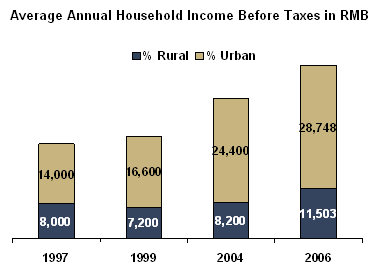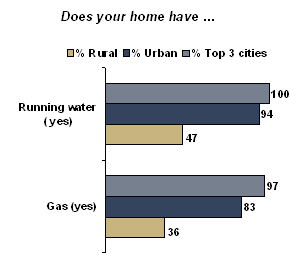GALLUP NEWS SERVICE
PRINCETON, NJ -- Despite China's rapid economic growth and urbanization, a majority of its 1.3 billion residents still live in rural areas (the population is currently split between 560 million urbanites and 745 million rural dwellers, according to Chinese government statistics). Uneven development has, in a very real sense, split China into two economies: urban and rural. In contrast to significant income growth in urban areas, rural incomes only saw moderate growth until 2004.
Thus far, the income gap between rich and poor in urban areas shows no sign of narrowing. In Gallup's most recent poll of China, conducted in October 2006, urban respondents reported an average annual income of 28,748 RMB, an increase of more than 4,000 RMB since the 2004 survey. Respondents in rural households also saw their average income rise, but by a somewhat lower 3,300 RMB. However, it's important to note that rural incomes are rising at an accelerating rate; from 1999 to 2004, rural respondents' average reported income rose by only 1,000 RMB.

But even within China's urban and rural "sub-economies," gaps between the "haves" and "have-nots" are widening. In the cities, the average income of the highest-earning 20% of urban Chinese jumped by almost 40% between 2004 and 2006, while the lowest-earning 20% of urban respondents saw a rise of about 27%. In rural areas, the average income gap between the upper and lower quintiles was stagnant until 2004, but has since widened considerably. The increase suggests the emergence of a nascent class of "rural rich" Chinese, the first beneficiaries of the country's capital-intensive growth to live outside the cities.
There are still significant quality-of-life differences between urban and rural Chinese, even regarding such basics as running water and gas for cooking. The vast majority of urban residents -- 94% -- say their homes have running water, but less than half of those in rural areas -- 47% -- say the same.

Survey Methods
Results are based on 3,730 face-to-face interviews conducted across China in October 2006, with residents aged 15 and older. For results based on the total sample, one can say with 95% confidence that the maximum error attributable to sampling and other random effects is ±2 percentage points. In addition to sampling error, question wording and practical difficulties in conducting surveys can introduce error or bias into the findings of public opinion polls.
